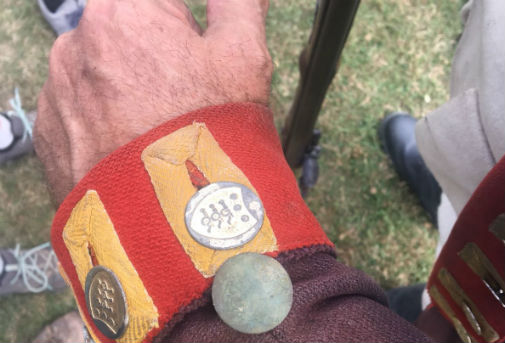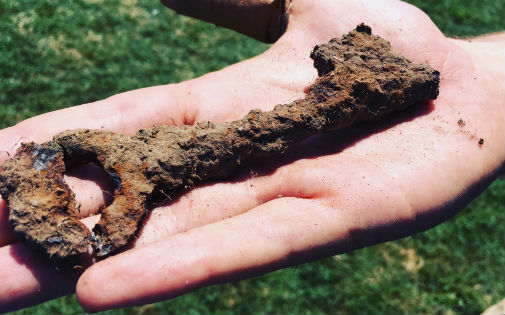Archaeologists step closer to unravelling Army life at Elizabeth Castle
Posted on 6 July 2018

The brass button is from the uniform of an officer of the Board of Ordnance
Elizabeth Castle is a complex site with origins as a defensive island fortress in the 16th Century, which was later occupied by the German army during the Second World War.
The team of archaeologists, working with Jersey Heritage, aim to discover the location of the barracks blocks and uncover more about the people that used the building.
After a week of excavations, they have already found structural evidence of the barracks, included walls and a cobbled floor, and a more contemporary door key.
Board of Ordnance
The brass button is from the uniform of an officer of the Board of Ordnance, dating to the 18th Century. The button is a rare find because there would have only been one Board of Ordnance Officer based at the castle.
Dr Catriona Cooper, from the University of York’s Department of Archaeology, said: “The Board of Ordnance was a government body established in the Tudor period to act primarily as custodians to the areas required in defence of the country.
“It is exciting to find this button, because there would have only been one officer that wore this uniform at Elizabeth Castle. He would have had oversight of the castle’s defences and its army supplies, such as weaponry.”

The team also found a key at the site, thought to be contemporary to the site
Using data produced by an archives team at the University of York and Jersey Archive, the archaeologists were able to identify four key areas where trenches could be created for the search for artefacts and potential evidence of the original structure of the site.
Archaeologists are also investigating an early 19th Century hospital block, utilising digital visualisation techniques, to produce a better understanding of the make-up of the building. It is hoped that the completed work will assist Jersey Heritage to enhance the visitor experience to the site.
Dr Cooper said: “We have also uncovered a comb, tokens and coins, as well as lots of clay pipes ceramics and building materials. The aim will be to open these finds up to the public and reveal more about the life at the hospital and barracks sites to allow for a clearer window into the past of this fascinating castle site.”
The project is the first year in what is hoped to be an ongoing collaboration with Jersey Heritage.
Explore more news

New butterfly species created 200,000 years ago by two species interbreeding
Thursday 18 April 2024

Children in the North at greater risk of entering care
Wednesday 17 April 2024

Boreal forest and tundra regions worst hit over next 500 years of climate change, study shows
Monday 8 April 2024

Researchers developing ultra-sensitive blood test with potential to revolutionise diagnosis of Alzheimer’s
Thursday 4 April 2024

Attitudes to being an adult are shifting as traditional milestones become out of reach, new study finds
Wednesday 27 March 2024
Media enquiries
About this research
The research at the University of York's Department of Archaeology with Dr Catriona Cooper and Project Directors Dr Dave Smith and Dr Matt Jenkins, is supported by Jersey Heritage.
Explore our research.
